Cellular respiration an overview 9.1 – Cellular respiration, an overview 9.1, embarks on a journey into the intricate world of energy production within living cells. This fundamental process, a cornerstone of cellular life, provides the fuel that powers a myriad of essential functions, from muscle contraction to brain activity.
Join us as we delve into the stages, significance, and regulation of cellular respiration, uncovering the secrets of how cells harness energy from nutrients to sustain life.
Cellular respiration, the process by which cells generate energy from organic molecules, is essential for the survival and function of all living organisms. This complex process involves a series of biochemical reactions that break down glucose, releasing energy that is stored in the form of ATP (adenosine triphosphate).
Introduction to Cellular Respiration
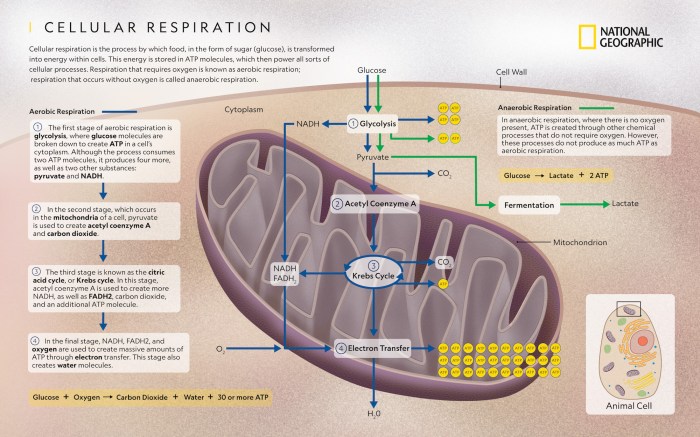
Cellular respiration is a set of metabolic reactions that take place in the cells of organisms to convert biochemical energy from nutrients into adenosine triphosphate (ATP), and then release waste products. This process is essential for the survival of all living organisms because ATP serves as the main energy currency for cells.
The overall equation for cellular respiration is:
C6H 12O 6(glucose) + 6O 2(oxygen) → 6CO 2(carbon dioxide) + 6H 2O (water) + energy (as ATP)
This equation indicates that glucose, a sugar molecule, is broken down in the presence of oxygen to produce carbon dioxide, water, and energy in the form of ATP.
Purpose of Cellular Respiration
The primary purpose of cellular respiration is to generate ATP, which is the main energy currency for cells. ATP is used to power various cellular processes, including:
- Muscle contraction
- Active transport of molecules across cell membranes
- Protein synthesis
- Cell division
- Chemical reactions involved in metabolism
Without cellular respiration, cells would not have the energy necessary to perform these essential functions and would eventually die.
Stages of Cellular Respiration
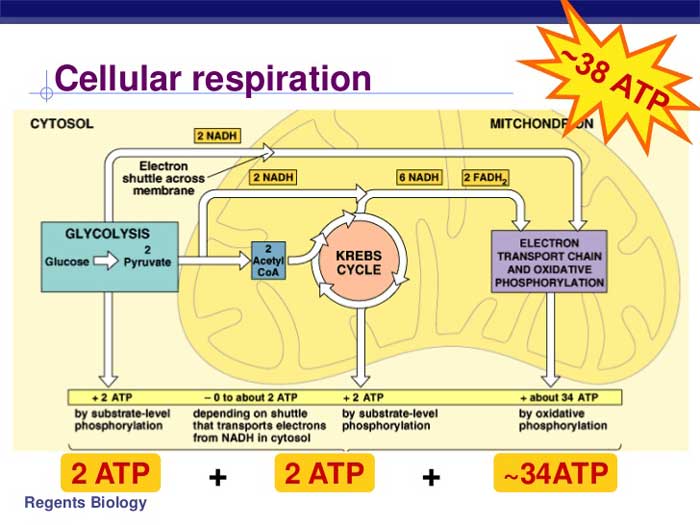
Cellular respiration is a complex process that occurs in the cells of all living organisms. It is a series of chemical reactions that break down glucose, a sugar molecule, to produce energy in the form of ATP.
Cellular respiration occurs in three main stages: glycolysis, the Krebs cycle, and the electron transport chain. Each stage plays a specific role in the overall process.
Glycolysis
Glycolysis is the first stage of cellular respiration. It occurs in the cytoplasm of the cell and does not require oxygen. In glycolysis, glucose is broken down into two molecules of pyruvate, releasing two molecules of ATP and two molecules of NADH.
Krebs Cycle
The Krebs cycle, also known as the citric acid cycle, is the second stage of cellular respiration. It occurs in the mitochondria of the cell and requires oxygen. In the Krebs cycle, pyruvate is further broken down, releasing two molecules of ATP, three molecules of NADH, one molecule of FADH2, and one molecule of GTP.
Electron Transport Chain
The electron transport chain is the third and final stage of cellular respiration. It occurs in the inner membrane of the mitochondria. In the electron transport chain, NADH and FADH2 donate electrons to a series of electron carriers. These electrons are passed along the chain, releasing energy that is used to pump protons across the membrane.
The protons then flow back across the membrane through ATP synthase, an enzyme that synthesizes ATP.
Glycolysis: Cellular Respiration An Overview 9.1
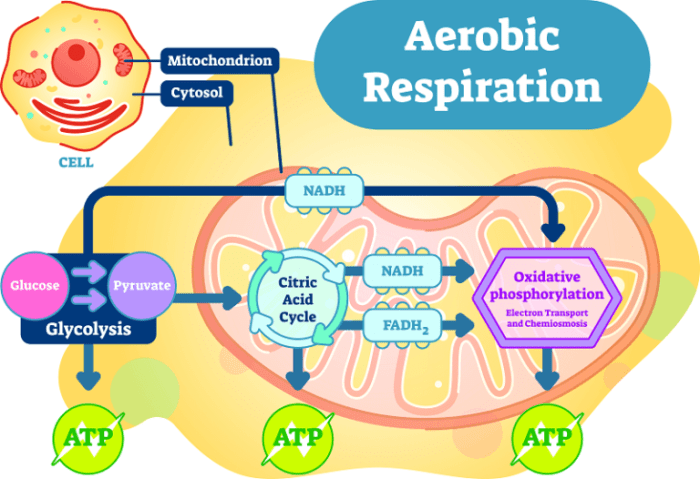
Glycolysis, the first stage of cellular respiration, is a metabolic pathway that breaks down glucose into pyruvate, releasing energy in the form of ATP.
Glycolysis occurs in the cytoplasm of the cell and involves a series of ten enzymatic reactions. The initial step is the phosphorylation of glucose, which is catalyzed by hexokinase. This is followed by a series of isomerization, oxidation, and phosphorylation reactions that ultimately result in the formation of two pyruvate molecules.
Energy Yield and Products of Glycolysis
Glycolysis generates a net yield of two molecules of ATP and two molecules of NADH. NADH is a high-energy electron carrier that will be used in the later stages of cellular respiration to generate additional ATP.
In addition to ATP and NADH, glycolysis also produces two molecules of pyruvate. Pyruvate is the starting material for the citric acid cycle, the second stage of cellular respiration.
Krebs Cycle (Citric Acid Cycle)
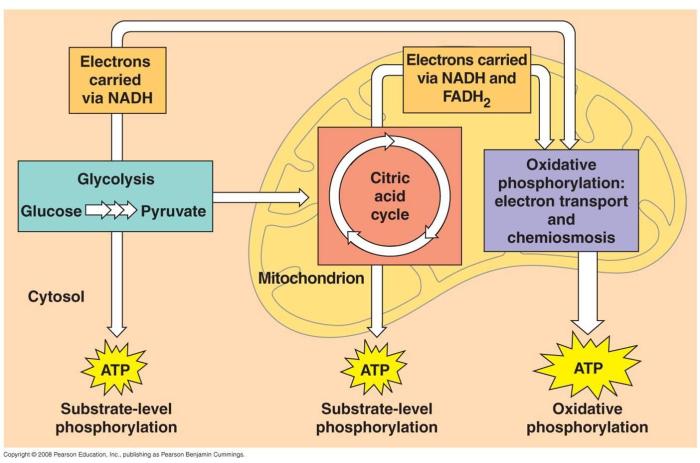
The Krebs cycle, also known as the citric acid cycle or tricarboxylic acid (TCA) cycle, is a series of chemical reactions that occur in the mitochondria of eukaryotic cells and the cytoplasm of prokaryotic cells. It is a central metabolic pathway that generates energy and reducing power in the form of ATP and NADH, respectively.The
Krebs cycle consists of eight enzymatic steps that involve the oxidation of acetyl-CoA, derived from the breakdown of carbohydrates, fats, and proteins, to produce carbon dioxide. The cycle is named after the scientist Hans Adolf Krebs, who first described it in the 1930s.
Steps of the Krebs Cycle
The steps of the Krebs cycle are as follows:
1. Citrate synthase
Acetyl-CoA combines with oxaloacetate to form citrate.
2. Aconitase
Citrate is isomerized to isocitrate.
3. Isocitrate dehydrogenase
Isocitrate is oxidized to α-ketoglutarate, releasing CO 2and NADH.
4. α-Ketoglutarate dehydrogenase
α-Ketoglutarate is oxidized to succinyl-CoA, releasing CO 2and NADH.
5. Succinyl-CoA synthetase
Succinyl-CoA is converted to succinate, releasing ATP.
6. Succinate dehydrogenase
Succinate is oxidized to fumarate, releasing FADH 2.
7. Fumarase
Fumarate is isomerized to malate.
8. Malate dehydrogenase
Malate is oxidized to oxaloacetate, releasing NADH.
Role of the Krebs Cycle in Energy and Reducing Power Generation
The Krebs cycle plays a crucial role in generating energy and reducing power for the cell. The oxidation of acetyl-CoA during the cycle releases CO 2and generates NADH and FADH 2, which are high-energy electron carriers. These electron carriers are used in the electron transport chain to generate ATP, the cell’s primary energy currency.In
addition to generating energy, the Krebs cycle also provides reducing power in the form of NADH and FADH 2. These electron carriers are used in various cellular processes, such as the synthesis of lipids, proteins, and nucleic acids.
Electron Transport Chain
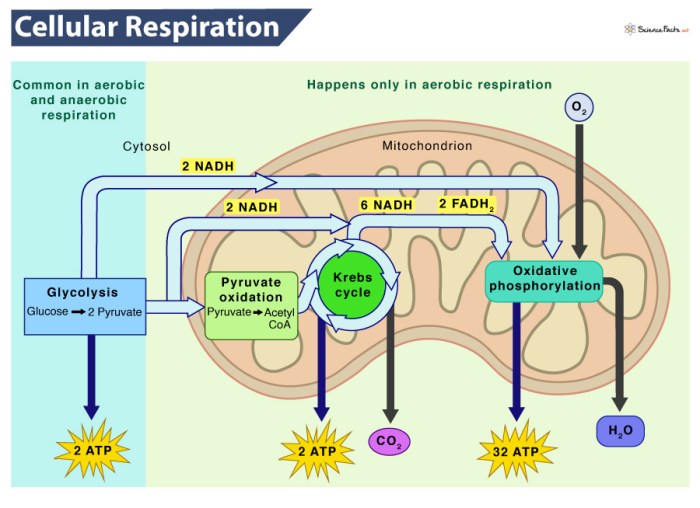
The electron transport chain (ETC) is a series of membrane-bound protein complexes located in the inner mitochondrial membrane. It plays a crucial role in cellular respiration by accepting electrons from NADH and FADH2 and using them to generate a proton gradient across the membrane.
The ETC consists of four protein complexes (complexes I-IV) and two mobile electron carriers (coenzyme Q and cytochrome c). As electrons pass through the ETC, they lose energy, which is used to pump protons from the mitochondrial matrix into the intermembrane space.
This creates a proton gradient, which drives the synthesis of ATP through ATP synthase.
Oxidative Phosphorylation
Oxidative phosphorylation is the process by which the ETC generates ATP. As protons flow back into the mitochondrial matrix through ATP synthase, the energy released is used to drive the synthesis of ATP from ADP and inorganic phosphate (Pi).
Oxidative phosphorylation is a highly efficient process that generates a large amount of ATP. It is estimated that about 90% of the ATP produced during cellular respiration is generated through oxidative phosphorylation.
Regulation of Cellular Respiration
Cellular respiration is a complex process that is tightly regulated to ensure that cells have the energy they need to function properly. A variety of factors can regulate cellular respiration, including the availability of oxygen, the levels of ATP and ADP, and the activity of key enzymes.
When oxygen is available, cells can carry out aerobic respiration, which is a more efficient way to produce ATP than anaerobic respiration. However, when oxygen is not available, cells must switch to anaerobic respiration, which is a less efficient way to produce ATP.
The availability of oxygen is regulated by the respiratory system, which brings oxygen into the lungs and transports it to the cells.
The levels of ATP and ADP also regulate cellular respiration. When the levels of ATP are high, cellular respiration is inhibited. This is because ATP is the energy currency of the cell, and when there is enough ATP, the cell does not need to produce more.
When the levels of ADP are high, cellular respiration is stimulated. This is because ADP is the molecule that is converted into ATP, and when there is a lot of ADP, the cell needs to produce more ATP.
The activity of key enzymes also regulates cellular respiration. These enzymes catalyze the reactions that occur during cellular respiration, and their activity can be regulated by a variety of factors, including the availability of substrates, the presence of inhibitors, and the temperature.
Adaptation to Different Metabolic Needs
Cellular respiration is adapted to different metabolic needs by varying the rate of ATP production. When cells need more energy, they increase the rate of ATP production by increasing the activity of key enzymes and by increasing the availability of substrates.
When cells need less energy, they decrease the rate of ATP production by decreasing the activity of key enzymes and by decreasing the availability of substrates.
The rate of ATP production is also regulated by the type of fuel that is being used. Carbohydrates are the preferred fuel for cellular respiration, but cells can also use fats and proteins. The rate of ATP production is higher when carbohydrates are used as the fuel than when fats or proteins are used.
Cellular respiration is a complex process that is essential for life. It is regulated by a variety of factors to ensure that cells have the energy they need to function properly.
Importance of Cellular Respiration
Cellular respiration is the process by which cells convert energy from nutrients into adenosine triphosphate (ATP), the cell’s main energy currency. ATP provides the energy for various cellular processes, including muscle contraction, protein synthesis, and cell division.
Without cellular respiration, cells would not have the energy to carry out these essential functions. This would lead to a breakdown in cellular homeostasis and ultimately cell death.
Consequences of Impaired Cellular Respiration
Impaired cellular respiration can have several consequences, including:
- Reduced ATP production:This can lead to a decrease in cellular energy levels and an inability to perform essential cellular functions.
- Increased production of reactive oxygen species (ROS):ROS are harmful molecules that can damage cells and contribute to aging and disease.
- Cell death:If cellular respiration is severely impaired, cells may undergo apoptosis (programmed cell death) or necrosis (uncontrolled cell death).
Clinical Significance
Cellular respiration is crucial for maintaining cellular homeostasis and energy production. However, disruptions in cellular respiration can lead to various diseases and conditions.
Impaired cellular respiration can result from genetic defects, mitochondrial dysfunction, or environmental toxins. These disruptions can affect any stage of cellular respiration, leading to reduced ATP production and cellular dysfunction.
Diseases Related to Impaired Cellular Respiration
- Mitochondrial diseases:Inherited disorders that affect mitochondrial function, leading to impaired oxidative phosphorylation and energy production.
- Cancer:Cancer cells often exhibit altered cellular respiration, relying more on glycolysis even in the presence of oxygen (Warburg effect).
- Neurodegenerative diseases:Conditions like Alzheimer’s and Parkinson’s diseases involve mitochondrial dysfunction and oxidative stress, contributing to neuronal damage.
Therapeutic Interventions Targeting Cellular Respiration, Cellular respiration an overview 9.1
Therapeutic strategies aimed at improving cellular respiration are being explored to address diseases related to impaired respiration.
- Mitochondrial replacement therapy:Transplantation of healthy mitochondria into affected cells to restore oxidative phosphorylation.
- Antioxidants:Substances that scavenge free radicals and protect against oxidative damage, which can improve mitochondrial function.
- Metabolic modulators:Compounds that target specific enzymes or pathways involved in cellular respiration, enhancing ATP production.
FAQ Summary
What is the overall equation for cellular respiration?
C6H12O6 + 6O2 → 6CO2 + 6H2O + energy (as ATP)
What is the role of glycolysis in cellular respiration?
Glycolysis is the first stage of cellular respiration and occurs in the cytoplasm. It breaks down glucose into two pyruvate molecules, releasing a small amount of energy in the form of ATP.
What is the role of the Krebs cycle in cellular respiration?
The Krebs cycle, also known as the citric acid cycle, is the second stage of cellular respiration and occurs in the mitochondrial matrix. It further breaks down pyruvate, releasing carbon dioxide and generating NADH and FADH2, which are used in the electron transport chain to produce ATP.
What is the role of the electron transport chain in cellular respiration?
The electron transport chain is the third and final stage of cellular respiration and occurs in the inner mitochondrial membrane. It uses the energy from NADH and FADH2 to pump protons across the membrane, creating a proton gradient. This gradient is used to drive the synthesis of ATP through a process called oxidative phosphorylation.